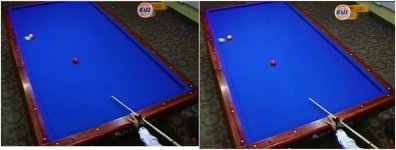This diagram of JAL's, courtesy of the Doctor, is almost correct if used as a side view. The cue shaft should have a slight downward trajectory and not appear to be level with the playing surface.
Cueing, by stroking through the cue ball above center, will cause a small hop and loss of grip with the table causing it to move farther along the tangent line before it regains friction with the table cloth. The upstroke is used to lessen the effects of the ball leaving the playing surface by not exerting as much force directed into the table, but rather more parallel with it by directing the force closer to the same plane as the table bed.
There are several plusses besides the obvious one of lessening the cue ball deflection, when needed, in tight traffic. I find predicting the cue ball path because of this limited movement a personal advantage, as I'm sure others would agree.
The faster cloth requires better speed control with pocket speed on many shots a premium. Friction and cut induced throw is a problem when the cue ball can't travel long distances for position. The up stroke helps this by eliminating the cling from a rolling cue ball due to the small increase in top spin. You can cut the balls slightly thinner and hit the ball softer avoiding a portion of the CIT.
You don't approach forward roll with the cue ball until you cut the ball, is a gauge I use. At first I thought the extra forward spin from my stroke would move the cue ball forward even farther than slow rolling it. With a slightly thicker hit on the object ball, I offset the spin and get a slower moving cue ball.
If this makes sense, there's more.
Best,
Mike
Since you don't want to hear anything from me, just ask Dr. Dave what he thinks about what you wrote above.

